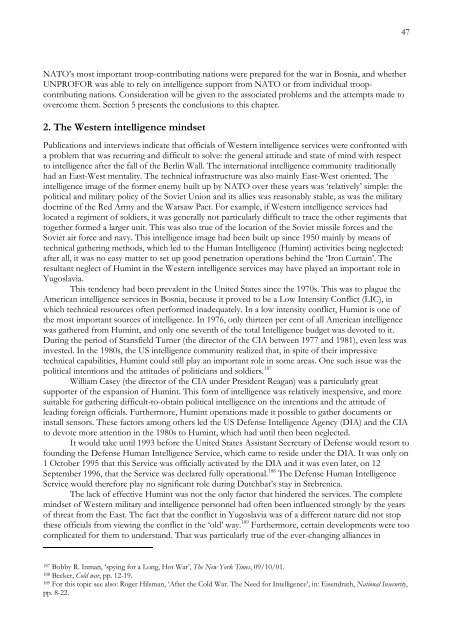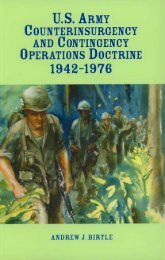C. Wiebes - Intelligence en de oorlog in Bosnië 1992-1995. De rol van de inlichtingen- en veiligheidsdiensten - Engels
C. Wiebes - Intelligence en de oorlog in Bosnië 1992-1995. De rol van de inlichtingen- en veiligheidsdiensten - Engels
C. Wiebes - Intelligence en de oorlog in Bosnië 1992-1995. De rol van de inlichtingen- en veiligheidsdiensten - Engels
- No tags were found...
Create successful ePaper yourself
Turn your PDF publications into a flip-book with our unique Google optimized e-Paper software.
47NATO’s most important troop-contribut<strong>in</strong>g nations were prepared for the war <strong>in</strong> Bosnia, and whetherUNPROFOR was able to rely on <strong>in</strong>tellig<strong>en</strong>ce support from NATO or from <strong>in</strong>dividual troopcontribut<strong>in</strong>gnations. Consi<strong>de</strong>ration will be giv<strong>en</strong> to the associated problems and the attempts ma<strong>de</strong> toovercome them. Section 5 pres<strong>en</strong>ts the conclusions to this chapter.2. The Western <strong>in</strong>tellig<strong>en</strong>ce m<strong>in</strong>dsetPublications and <strong>in</strong>terviews <strong>in</strong>dicate that officials of Western <strong>in</strong>tellig<strong>en</strong>ce services were confronted witha problem that was recurr<strong>in</strong>g and difficult to solve: the g<strong>en</strong>eral attitu<strong>de</strong> and state of m<strong>in</strong>d with respectto <strong>in</strong>tellig<strong>en</strong>ce after the fall of the Berl<strong>in</strong> Wall. The <strong>in</strong>ternational <strong>in</strong>tellig<strong>en</strong>ce community traditionallyhad an East-West m<strong>en</strong>tality. The technical <strong>in</strong>frastructure was also ma<strong>in</strong>ly East-West ori<strong>en</strong>ted. The<strong>in</strong>tellig<strong>en</strong>ce image of the former <strong>en</strong>emy built up by NATO over these years was ‘relatively’ simple: thepolitical and military policy of the Soviet Union and its allies was reasonably stable, as was the militarydoctr<strong>in</strong>e of the Red Army and the Warsaw Pact. For example, if Western <strong>in</strong>tellig<strong>en</strong>ce services hadlocated a regim<strong>en</strong>t of soldiers, it was g<strong>en</strong>erally not particularly difficult to trace the other regim<strong>en</strong>ts thattogether formed a larger unit. This was also true of the location of the Soviet missile forces and theSoviet air force and navy. This <strong>in</strong>tellig<strong>en</strong>ce image had be<strong>en</strong> built up s<strong>in</strong>ce 1950 ma<strong>in</strong>ly by means oftechnical gather<strong>in</strong>g methods, which led to the Human <strong>Intellig<strong>en</strong>ce</strong> (Hum<strong>in</strong>t) activities be<strong>in</strong>g neglected:after all, it was no easy matter to set up good p<strong>en</strong>etration operations beh<strong>in</strong>d the ‘Iron Curta<strong>in</strong>’. Theresultant neglect of Hum<strong>in</strong>t <strong>in</strong> the Western <strong>in</strong>tellig<strong>en</strong>ce services may have played an important <strong>rol</strong>e <strong>in</strong>Yugoslavia.This t<strong>en</strong>d<strong>en</strong>cy had be<strong>en</strong> preval<strong>en</strong>t <strong>in</strong> the United States s<strong>in</strong>ce the 1970s. This was to plague theAmerican <strong>in</strong>tellig<strong>en</strong>ce services <strong>in</strong> Bosnia, because it proved to be a Low Int<strong>en</strong>sity Conflict (LIC), <strong>in</strong>which technical resources oft<strong>en</strong> performed <strong>in</strong>a<strong>de</strong>quately. In a low <strong>in</strong>t<strong>en</strong>sity conflict, Hum<strong>in</strong>t is one ofthe most important sources of <strong>in</strong>tellig<strong>en</strong>ce. In 1976, only thirte<strong>en</strong> per c<strong>en</strong>t of all American <strong>in</strong>tellig<strong>en</strong>cewas gathered from Hum<strong>in</strong>t, and only one sev<strong>en</strong>th of the total <strong>Intellig<strong>en</strong>ce</strong> budget was <strong>de</strong>voted to it.Dur<strong>in</strong>g the period of Stansfield Turner (the director of the CIA betwe<strong>en</strong> 1977 and 1981), ev<strong>en</strong> less was<strong>in</strong>vested. In the 1980s, the US <strong>in</strong>tellig<strong>en</strong>ce community realized that, <strong>in</strong> spite of their impressivetechnical capabilities, Hum<strong>in</strong>t could still play an important <strong>rol</strong>e <strong>in</strong> some areas. One such issue was thepolitical <strong>in</strong>t<strong>en</strong>tions and the attitu<strong>de</strong>s of politicians and soldiers. 187William Casey (the director of the CIA un<strong>de</strong>r Presid<strong>en</strong>t Reagan) was a particularly greatsupporter of the expansion of Hum<strong>in</strong>t. This form of <strong>in</strong>tellig<strong>en</strong>ce was relatively <strong>in</strong>exp<strong>en</strong>sive, and moresuitable for gather<strong>in</strong>g difficult-to-obta<strong>in</strong> political <strong>in</strong>tellig<strong>en</strong>ce on the <strong>in</strong>t<strong>en</strong>tions and the attitu<strong>de</strong> oflead<strong>in</strong>g foreign officials. Furthermore, Hum<strong>in</strong>t operations ma<strong>de</strong> it possible to gather docum<strong>en</strong>ts or<strong>in</strong>stall s<strong>en</strong>sors. These factors among others led the US <strong>De</strong>f<strong>en</strong>se <strong>Intellig<strong>en</strong>ce</strong> Ag<strong>en</strong>cy (DIA) and the CIAto <strong>de</strong>vote more att<strong>en</strong>tion <strong>in</strong> the 1980s to Hum<strong>in</strong>t, which had until th<strong>en</strong> be<strong>en</strong> neglected.It would take until 1993 before the United States Assistant Secretary of <strong>De</strong>f<strong>en</strong>se would resort tofound<strong>in</strong>g the <strong>De</strong>f<strong>en</strong>se Human <strong>Intellig<strong>en</strong>ce</strong> Service, which came to resi<strong>de</strong> un<strong>de</strong>r the DIA. It was only on1 October 1995 that this Service was officially activated by the DIA and it was ev<strong>en</strong> later, on 12September 1996, that the Service was <strong>de</strong>clared fully operational. 188 The <strong>De</strong>f<strong>en</strong>se Human <strong>Intellig<strong>en</strong>ce</strong>Service would therefore play no significant <strong>rol</strong>e dur<strong>in</strong>g Dutchbat’s stay <strong>in</strong> Srebr<strong>en</strong>ica.The lack of effective Hum<strong>in</strong>t was not the only factor that h<strong>in</strong><strong>de</strong>red the services. The completem<strong>in</strong>dset of Western military and <strong>in</strong>tellig<strong>en</strong>ce personnel had oft<strong>en</strong> be<strong>en</strong> <strong>in</strong>flu<strong>en</strong>ced strongly by the yearsof threat from the East. The fact that the conflict <strong>in</strong> Yugoslavia was of a differ<strong>en</strong>t nature did not stop189these officials from view<strong>in</strong>g the conflict <strong>in</strong> the ‘old’ way. Furthermore, certa<strong>in</strong> <strong>de</strong>velopm<strong>en</strong>ts were toocomplicated for them to un<strong>de</strong>rstand. That was particularly true of the ever-chang<strong>in</strong>g alliances <strong>in</strong>187 Bobby R. Inman, ‘spy<strong>in</strong>g for a Long, Hot War’, The New York Times, 09/10/01.188 Becker, Cold war, pp. 12-19.189 For this topic see also: Roger Hilsman, ‘After the Cold War. The Need for <strong>Intellig<strong>en</strong>ce</strong>’, <strong>in</strong>: Eis<strong>en</strong>drath, National Insecurity,pp. 8-22.





